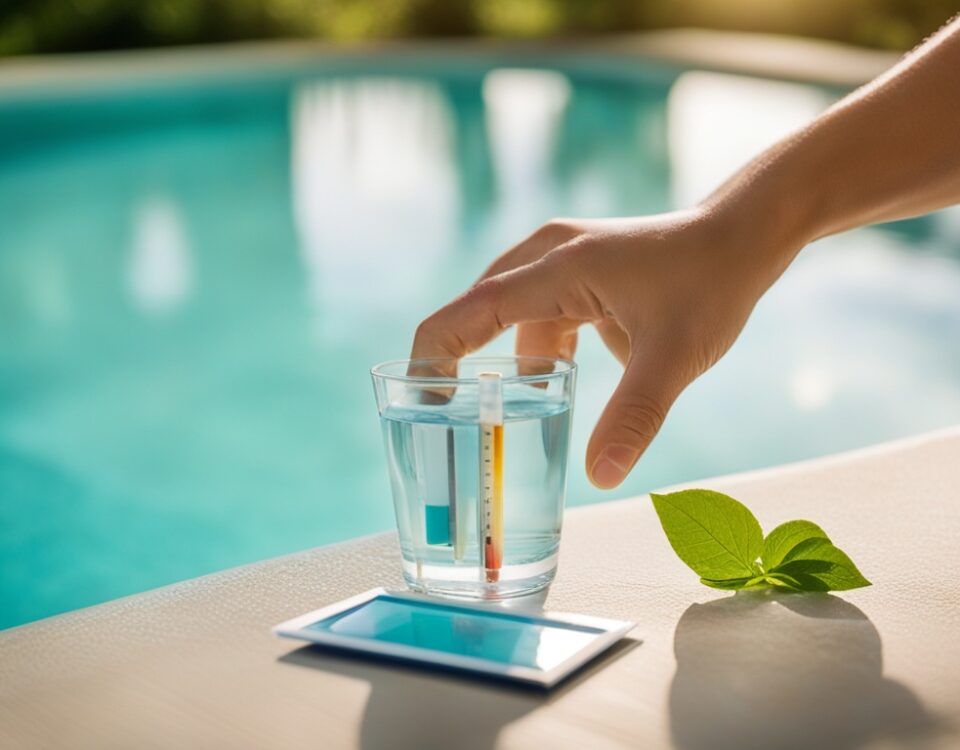Master Your Pool: Essential Filter Maintenance Tips!

Unveiling the True Concrete Pool Cost: Let’s Dive into Transparency
May 11, 2025
Dive into Style: Transform Your Pool with Stunning Retaining Walls
May 12, 2025Importance of Pool Filter Maintenance
Maintaining a pristine swimming pool is imperative for both aesthetics and safety. At the heart of this endeavor lies the pool filter, an often underappreciated yet *crucial component* of your pool’s ecosystem. Pool filters are designed to remove debris, contaminants, and microorganisms from the water, ensuring that it remains clean and safe for swimmers. By efficiently circulating and purifying the water, these filters help to maintain clarity and hygiene, allowing users to enjoy a refreshing swimming experience without the worry of exposure to harmful pathogens.
The Role of Filters in Water Quality
One of the primary functions of a pool filter is to *enhance water quality*. Filters work by trapping dirt and debris—ranging from leaves to human hair—thereby supporting the effectiveness of chemicals such as chlorine. This filtration process is vital in preventing the proliferation of bacteria and algae, which can compromise the pool’s safety. When filters are properly maintained, they create a balanced environment that discourages the growth of harmful microorganisms, allowing swimmers to enjoy crystal-clear water free from potential health hazards.
Consequences of Neglected Maintenance
Neglecting pool filter maintenance can lead to dire consequences for both the pool and its users. When filters are clogged or malfunctioning, they cannot effectively trap dirt and contaminants. This leads to *stagnant water*, which becomes a breeding ground for algae, bacteria, and other harmful pathogens. Algae blooms not only tarnish the pool’s clarity but may also result in slippery surfaces that pose safety risks for swimmers. Additionally, a pool that is not properly filtered may require more intensive chemical treatments to maintain hygiene, escalating both operational costs and chemical exposure.
Pump Damage and Operational Inefficiency
The implications of poor filter maintenance extend beyond water quality; they can also impact the operational efficiency of the pool’s filtration system. When filters are not cleaned or replaced regularly, debris can accumulate, causing undue strain on the pump. This strain can lead to *premature pump failure*, resulting in costly repairs or replacements that could have been avoided through regular maintenance. Moreover, an overworked pump may lead to higher energy consumption, thereby inflating electricity bills and wasting resources unnecessarily.
Maintaining Filter Health: A Proactive Approach
To ensure optimal functionality, it is essential to adopt a *proactive maintenance approach* for pool filters. Regularly cleaning or replacing the filter cartridge, backwashing sand filters, and checking for signs of wear and tear are integral steps toward maintaining the filter’s efficiency. It is advisable to set a schedule for routine maintenance, as this allows for the timely identification of potential issues before they escalate. Additionally, monitoring water chemistry in conjunction with filter upkeep ensures a wholesome environment for all swimmers while prolonging the life of the filtration system.
| Maintenance Task | Frequency | Purpose |
|---|---|---|
| Clean or Replace Filter Cartridge | Every 1-3 months | To ensure optimal filtration and water clarity |
| Backwash Sand Filter | As needed (Check pressure gauge) | To remove accumulated debris and maintain flow rate |
| Inspect Pump for Damage | Monthly | To prevent pump failure and ensure efficient operation |
In summary, the importance of pool filter maintenance cannot be overstated. By ensuring the filter operates effectively, pool owners can sustain a *clean, safe swimming environment* while reducing the likelihood of costly repairs and extensive chemical use. Regularly scheduled maintenance allocates both time and resources effectively, contributing to a more enjoyable and secure swimming experience.
Types of Pool Filters
Sand Filters
Sand filters are among the most popular choices for pool owners due to their *simplicity* and *effectiveness*. These systems operate by using sand as a filtration medium; water flows through the sand, trapping dirt and debris in the process. Typically, sand filters can remove particles as small as 20 microns, making them adequate for most residential pools.
Pros:
- Low maintenance— *backwashing* is required only every few weeks.
- Cost-effective initial investment compared to other types.
- Durable design— *sand* can last up to five years before needing replacement.
Cons:
- Less efficient at capturing *smaller particles* compared to cartridge and DE filters.
- Requires a *backwash process* which wastes a significant amount of water.
Cartridge Filters
Cartridge filters utilize a folded, pleated filter media that captures debris as water flows through it. Unlike sand filters, they do not require backwashing, making them a *water-efficient* option. They can trap particles as small as 10 microns, offering superior filtration compared to traditional sand filters.
Pros:
- Able to filter out smaller particles for enhanced *water clarity*.
- Low water consumption; no backwashing needed.
- Easy to maintain—simply remove and clean the cartridge.
Cons:
- Higher initial cost due to the *cartridge replacement* expenses.
- Cartridges need to be replaced approximately every 1-2 years.
DE Filters
Diatomaceous Earth (DE) filters utilize fossilized remains of tiny aquatic organisms to trap dirt and debris, achieving remarkable filtration with the capability to capture particles down to 3 microns. This level of *efficiency* makes DE filters the go-to choice for many commercial pools and discerning homeowners.
Pros:
- Exceptional filtration capabilities—removes the *finest particles* for crystal-clear water.
- Maintains *water quality* with fewer chemicals needed due to superior filtration.
- Long-lasting if maintained properly—can endure multiple cleaning cycles.
Cons:
- More complex maintenance and installation processes compared to sand and cartridge filters.
- Requires more *frequent backwashing*, which can increase water consumption.
- Initial setup cost is typically the highest among the three types.
| Filter Type | Particle Removal (Microns) | Maintenance Level | Initial Cost | Water Consumption |
|---|---|---|---|---|
| Sand Filter | 20 | Low | Low | Medium (backwashing) |
| Cartridge Filter | 10 | Medium | Medium | Low (no backwashing) |
| DE Filter | 3 | High | High | High (frequent backwashing) |
Frequency of Filter Cleaning
To maintain a pristine swimming pool, understanding the frequency of filter cleaning is imperative. The cleaning schedule can significantly influence the efficiency of the pool’s filtration system and the overall cleanliness of the water. Various factors play a crucial role in determining how often you should clean your pool filter, including pool size, usage, and environmental conditions.
General Cleaning Schedule
A good rule of thumb for the average pool owner is to clean the filter every four to six weeks. However, this can vary widely depending on specific circumstances. For instance, larger pools, which generally have a greater volume of water to filter, may require more frequent cleaning—every three to four weeks—especially during peak usage periods such as summer months or during pool parties. Meanwhile, smaller inflatable or kiddie pools may need less frequent maintenance.
Impact of Pool Usage
The frequency of usage of your swimming pool contributes significantly to filter maintenance needs. If your pool is frequently used by families or groups, or if you have children or pets splashing around, debris and contaminants can accumulate rapidly. In such cases, it is advisable to clean the filter every two to three weeks. Conversely, if your pool sees minimal use, adjusting the cleaning schedule to once every six to eight weeks might suffice.
Environmental Considerations
External factors, such as surrounding vegetation and climate conditions, also play a pivotal role in determining cleaning frequency. Pools situated near lush gardens or dense trees may experience increased debris, leading to more frequent filter cleanings—ideally every two weeks. Additionally, in warmer climates where algae growth is rampant, you might require a routine clean every two to four weeks to avert any growth that could clog the filter.
Types of Filters and Maintenance Frequency
Different types of pool filters—sand, cartridge, and DE (diatomaceous earth)—may necessitate distinct cleaning protocols. For instance, a sand filter typically requires backwashing every 4-6 weeks, while a cartridge filter needs to be removed and cleaned with a hose every 4-6 months, depending on usage and environmental factors. DE filters, on the other hand, may require recharging with DE filter powder after backwashing and should be cleaned every 3-6 months to ensure optimal functioning.
Monitoring Filter Performance
Regular maintenance is not merely a suggestion; it is *paramount* for ensuring optimal performance of your pool filter. Monitoring the pressure gauge associated with your filter can provide clear indicators of when cleaning is necessary. A significant rise in pressure, typically around 8-10 PSI above the normal operating range, is a telltale sign that your filter needs attention. Keeping a vigilant eye on these metrics can enhance the longevity of the filter and ensure that your pool remains a clean and inviting oasis.
| Factors Influencing Cleaning Frequency | Recommended Cleaning Frequency |
|---|---|
| Average Usage | 4-6 weeks |
| Heavily Used Pools | 2-3 weeks |
| Small Pools | 6-8 weeks |
| High Debris Areas | 2-4 weeks |
| Sand Filters | 4-6 weeks (backwash) |
| Cartridge Filters | 4-6 months |
| DE Filters | 3-6 months |
Steps to Clean a Pool Filter
Cleaning Sand Filters
Cleaning a sand filter is an essential task to ensure optimal performance and clean water. Begin by shutting off the pool pump to prevent any accidents during the cleaning process. Next, you should place the filter valve in the *backwash* position. By doing so, you will reverse the flow of water, dislodging trapped debris and dirt.
After backwashing for about 2-3 minutes, switch the valve back to the *filter* position and run the pump for another minute to reset the filter. Follow this by checking the pressure gauge; a drop of 8-10 psi from your usual backwash pressure indicates a need for cleaning. Finally, ensure that you rinse the filter thoroughly to remove any remaining particles.
Cleaning Cartridge Filters
Cartridge filters require a slightly different approach. Start by shutting off the pool pump and *removing the cartridges* from the filter housing. Use a hose to rinse off any large debris, ensuring that you clear out the pleats where dirt tends to accumulate. For deeper cleaning, consider soaking the cartridges in a solution of water and filter cleaner for a few hours.
After soaking, rinse the cartridges thoroughly with a hose. Ensure that no soap residue remains to maintain water quality. Reinstall the cartridges and turn on the pump. It’s advisable to check for any leaks around the cartridge’s o-ring to avoid water loss.
Cleaning DE Filters
DE (Diatomaceous Earth) filters require meticulous maintenance. Begin by shutting off the pump and opening the filter tank to access the grids. Remove the grids and rinse them with water to clear away the DE powder and dirt. For a thorough cleanse, soak the grids in a solution of water and filter cleaner for the recommended duration.
Once cleaned and rinsed, replace the grids back into the filter and recharge the filter with fresh DE powder. A general guideline is to use one pound of DE for every 10 square feet of filter area. Don’t forget to activate the pump and monitor for any leaks.
Tips and Tricks for Effective Cleaning
Regardless of the filter type, some general tips can enhance your cleaning process:
- Always consult your filter’s manual for specific cleaning recommendations.
- Schedule regular maintenance every 4-6 weeks to avoid buildup and ensure peak performance.
- Consider using a *filter cleaner* product to break down oils and other stubborn residues.
- Keep track of your water chemistry; optimal chlorine and pH levels extend the life of your filter.
Troubleshooting Common Issues
If you notice your pool water doesn’t clear up after cleaning, it may be indicative of underlying problems. A pressure reading that’s too high might suggest that the filter is clogged and needs immediate attention, while low pressure could indicate a malfunctioning pump. Always check the integrity of your filter’s components
For pool owners facing cloudy water, aside from checking the filter, ensure that regular shock treatments are administered. Additionally, a *pool clarifier* can help in binding finer particles for easier filtration.
Signs of a Dirty or Clogged Filter
Maintaining a pristine swimming pool is essential for ensuring that water remains clear and safe for use. One of the most vital components of this maintenance is the pool filter. Ignoring the condition of your filter can lead to costly repairs and hinder the overall efficiency of your pool system. Here are some *key indicators* that your pool filter may be dirty or clogged.
1. Decreased Water Flow
A significant warning sign of a failing filter is a noticeable *decrease in water flow*. If you observe that the water entering the pool is slower than usual, it may be time to assess your filter. This reduced flow is often a direct result of an accumulation of dirt and debris within the filter system, which impedes water circulation.
2. Increased Pressure Readings
Another clear indicator of a clogged filter is an increased *pressure reading on the filter gauge*. Most pool filters have a pressure relief gauge, and when the pressure exceeds the normal operating range—typically between 10 and 20 psi—it suggests that the filter is struggling to do its job. Generally, when the pressure is 8 to 10 psi above the normal reading, it signals that cleaning is necessary.
3. Cloudy or Discolored Water
If you notice that the pool water has become *cloudy or discolored*, your filter might not be effectively removing contaminants. Factors such as algae blooms or an increase in bacteria may arise when your filtration system is compromised. A dirty filter cannot trap particles efficiently, resulting in murky water that can deter swimmers.
4. Surface Debris Accumulation
Excessive debris accumulation on the surface of the water is another pertinent sign that your filter may not be functioning optimally. Leaves, dirt, and other contaminants should be filtered out efficiently, so if you find that debris is consistently lingering on the surface, it may indicate that your filter requires immediate attention.
Simple Tests to Determine Filter Condition
To accurately assess the condition of your pool filter, you can perform a couple of simple tests:
| Test | Procedure | What It Indicates |
|---|---|---|
| Pressure Gauge Reading | Check the pressure on the gauge when the filter is clean and compare it to current readings. | Identifies if the filter is clogged (>8-10 psi above normal). |
| Water Clarity | Visually inspect water quality daily. | Reflects the filter’s efficiency in removing contaminants. |
| Backwash Test (for sand filters) | If pressure is high, backwash the filter and compare the return flow. | Indicates the level of blockage in the filter media. |
By being vigilant and observant of these *warning signs*, pool owners can ensure their filter remains in good working order, ultimately prolonging its lifespan and keeping the pool water safe and inviting all season long.
DIY vs. Professional Filter Maintenance
When it comes to pool filter maintenance, the decision of whether to do it yourself (DIY) or hire a professional can significantly impact both the cleanliness of your pool and your overall maintenance budget. Understanding the benefits and drawbacks of each option is essential for every pool owner aiming to keep their oasis pristine.
Benefits of DIY Filter Maintenance
One of the most appealing aspects of DIY filter maintenance is the potential for significant *cost savings*. By handling the tasks yourself, you may save a considerable amount on labor costs associated with hiring a professional service. Furthermore, performing regular maintenance allows you to develop a more intimate understanding of your pool system and tailor your upkeep to its specific needs. Many homeowners find satisfaction in taking care of their pool personally, which can enhance their overall enjoyment of owning a swimming pool.
Drawbacks of DIY Maintenance
However, it is essential to acknowledge the potential *drawbacks* of undertaking filter maintenance yourself. For one, certain tasks can be quite *technically challenging,* especially for those lacking experience in pool care. Missteps can lead to further complications, requiring expensive repairs that could have easily been avoided with professional assistance. Moreover, maintaining a filter effectively demands consistent attention; the time commitment can be significant, particularly during peak swimming seasons when pools require more frequent servicing.
Advantages of Hiring Professionals
Turning to professional pool maintenance services brings a wealth of *experience* and *expertise* to the table. Professionals typically possess advanced training and knowledge, ensuring that your filter maintenance is performed to the highest standards. They can efficiently diagnose and address a range of issues that might not yet be apparent to an untrained eye, extending the lifespan of your pool equipment. Hiring a professional alsoRelieves you of the burdensome time commitment, allowing you to enjoy your pool without worrying about its upkeep.
Costs and Complexity of Tasks
When considering whether to opt for DIY maintenance or a professional service, it is crucial to weigh the *costs* involved. The following table provides a rough comparison of the financial implications associated with each option:
| Maintenance Task | DIY Cost Estimate | Professional Service Cost Estimate |
|---|---|---|
| Cartridge Replacement | $50 – $100 | $100 – $150 |
| Backwashing Sand Filter | Free (if done by owner) | $50 – $80 |
| Chemical Balancing | $20 – $60 (for chemicals) | $75 – $120 |
| General Inspection | Free (if inspected by owner) | $80 – $120 |
For *complex maintenance tasks*—such as deep cleaning systems, troubleshooting mechanical issues, or intricate repairs—hiring a professional often proves more prudent. Conversely, simpler tasks, like checking and cleaning skimmer baskets or performing regular backwashing, can be easily managed by most homeowners. As a general rule, if you feel confident and invested in your pool’s upkeep, DIY maintenance can be rewarding; however, do not hesitate to engage professionals for more complicated issues.
Advanced Filter Maintenance Techniques
Backwashing Your Pool Filter
One of the most crucial procedures in advanced pool filter maintenance is backwashing. This effective method is primarily used for sand and diatomaceous earth (DE) filters. Backwashing involves reversing the flow of water through the filter, dislodging trapped debris and pollutants. It is essential to perform this task when the pressure gauge exceeds the normal operating range, typically by 8 to 10 psi. Regularly backwashing not only preserves the filter’s efficiency but also prolongs its lifespan, ultimately keeping your pool water sparkling clean.
When to Backwash
Determining the right time to backwash your filter is integral for optimal performance. A general rule of thumb is to check the pressure gauge at least once a week during the swimming season. If your gauge indicates an increase beyond the norm, it’s time to initiate backwashing. Keep in mind that excessive backwashing can lead to water waste; therefore, be judicious and only backwash when necessary.
Acid Washing for Deep Cleaning
In some instances, traditional cleaning methods may not suffice, leading to the consideration of acid washing. This technique, predominantly used for plaster pools, involves applying a diluted acid solution to remove scaling and mineral buildup that can negatively affect water clarity and filter performance. Acid washing is typically performed annually, depending on the pool’s condition and water quality.
When to Acid Wash
Acid washing should be considered when you notice significant discoloration or cloudiness in your pool water, even after other maintenance techniques have been employed. Signs that your filter is not functioning correctly due to buildup include low water circulation and clogged skimmer lines. Always ensure to neutralize the pool’s pH levels and refill it after the procedure to avoid issues with chemistry.
Filter Media Replacement
Over time, filter media—whether sand, DE, or cartridge—will degrade and become less effective at trapping contaminants. It’s vital to understand when to replace your filter media. Sand typically lasts about 3 to 5 years, while DE powder should be changed out every 3 to 4 years. Cartridge filters can be cleaned but will need full replacement every 2 to 4 years.
Recognizing the Need for Replacement
To assess when to replace your filter media, keep an eye out for persistent issues such as poor water clarity, excessive pressure readings despite backwashing, or visible tears and holes in cartridge filters. Frequent cleaning may indicate that the media has lost its effectiveness. Implementing a structured maintenance schedule can help ensure that you address these concerns timely, optimizing your filter’s performance and, in turn, enhancing the overall aesthetic of your swimming pool.
Learn more about Swimming Pool

Javier Morales is passionate about pool design, maintenance, and outdoor living. With years of hands-on experience, he offers practical tips, creative ideas, and expert insights to help readers make the most of their pool spaces. At Piscina Planet, Javier shares everything from seasonal care guides to the latest trends in pool innovation.




